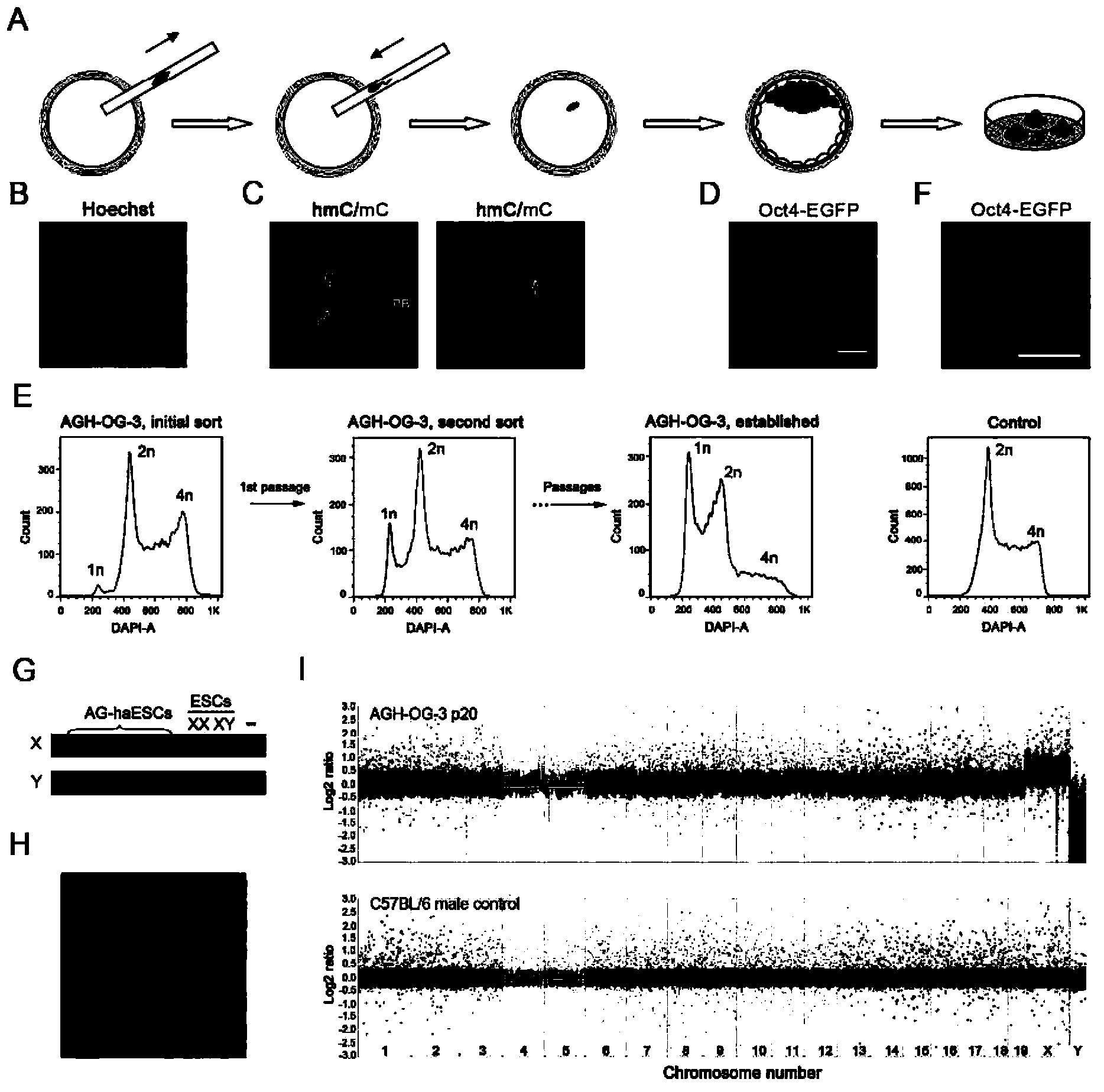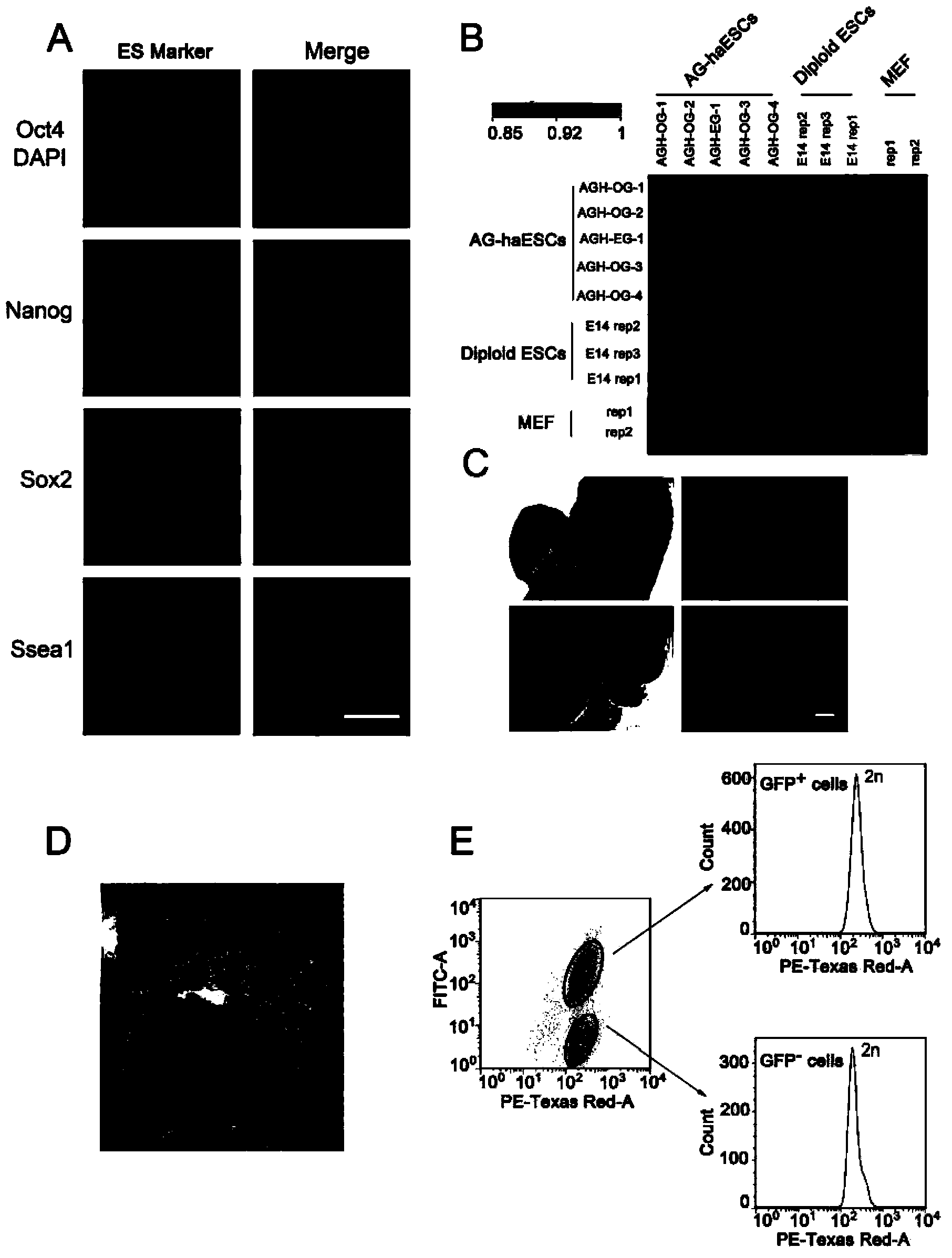Androgenesis haploid stem cell line as well as preparation method and application thereof
A haploid cell, single and single technology, applied in the direction of using virus/cell line methods, applications, embryonic cells, etc.
- Summary
- Abstract
- Description
- Claims
- Application Information
AI Technical Summary
Problems solved by technology
Method used
Image
Examples
Embodiment 1
[0113] Example 1 Establishment of androgenic haploid stem cells
[0114] Preparation of male haploid embryos:
[0115] Sperm: References (Kimura and Yanagimachi, 1995; Yang et al., 2011), collected sperm from Oct4-EGFP transgenic mice (purchased from Nanjing Institute of Model Animals) for intracytoplasmic sperm injection (ICSI) Prepare.
[0116] Egg cells: egg cell donors were from B6D2F1 (C57BL / 6×DBA2) female mice, and B6D2F1 female mice were purchased from Nanjing Institute of Model Animals.
[0117] Male haploid embryos were prepared using the following method:
[0118] The first method, the standard nuclear transfer method (ref. n et al., 2011; Wakayama et al., 1998), in which the somatic cell donor is replaced by the sperm head. Specifically, the oocytes were obtained 14 hours after the mice were injected with chorionic gonadotropin (HCG), and then cultured in HEPES-CZB medium containing 5 μg / ml cytochalasin B; It is customary to perform enucleation; after enucleatio...
Embodiment 2A
[0123] Pluripotency of Example 2AG-haESCs
[0124] AG-haESCs have the same clonal morphology as normal diploid mouse embryonic stem cells. Immunofluorescence analysis showed that markers of ES cells (including Nanog, Oct4, Sox2, and Ssea1) were present in haES clones ( figure 2 A) and in cells with only a single DNA content obtained by FACS (Table 1).
[0125] Table 1
[0126]
[0127] Gene expression profiles of normal ES cells and embryonic fibroblasts (MEFs) from male individuals were compared with AG-haESCs. To avoid the influence of diploidized cells on expression profiles, samples in G1 / G0 phase were collected by FACS. Cluster analysis of these cells obtained from microarray expression data showed that AG-haESCs had a high similarity to diploid ES cells, but not to MEFs ( figure 2 B).
[0128] To test the developmental potential of AG-haESCs, Actin-EGFP-labeled haploid cells (AGH-EG-1) were injected into ICR-derived diploid blastocysts to obtain chimeric mice w...
Embodiment 3
[0130] Example 3 Partial Maintenance of AG-haESCs Paternal Genome Imprint
[0131] Since the paternal imprint established at the stage of primordial germ cells prevails throughout the fertilization process and continues throughout the embryonic development process. In this example, the inventors tested whether these AG-haESCs maintained paternal imprinting.
[0132] Firstly, the expression of imprinted genes was compared between haploid and control diploid ESCs, and it was found that all paternal genes of AG-haESCs derived from androgens were imprinted, and genes expressed by maternal sources were down-regulated, except for the H19 gene; on the contrary, Maternally imprinted genes (expressed on paternal alleles) were upregulated (Table 1 and image 3 A). It indicated that AG-haESCs largely maintained a typical paternal imprinting background.
[0133] In order to further evaluate its epigenetic status, the methylation background of two paternally imprinted genes Gtl2 and H19...
PUM
 Login to View More
Login to View More Abstract
Description
Claims
Application Information
 Login to View More
Login to View More - R&D
- Intellectual Property
- Life Sciences
- Materials
- Tech Scout
- Unparalleled Data Quality
- Higher Quality Content
- 60% Fewer Hallucinations
Browse by: Latest US Patents, China's latest patents, Technical Efficacy Thesaurus, Application Domain, Technology Topic, Popular Technical Reports.
© 2025 PatSnap. All rights reserved.Legal|Privacy policy|Modern Slavery Act Transparency Statement|Sitemap|About US| Contact US: help@patsnap.com



